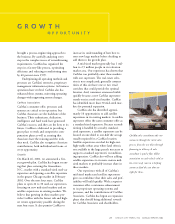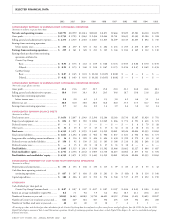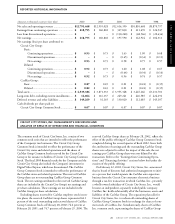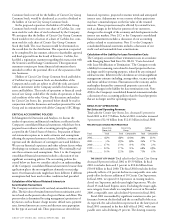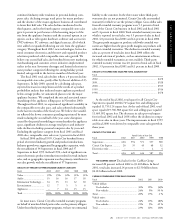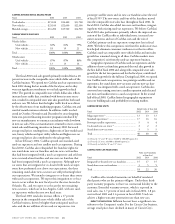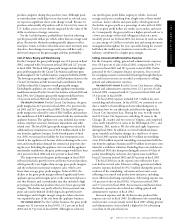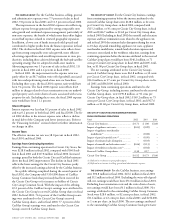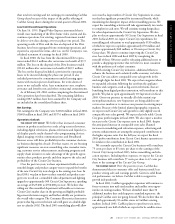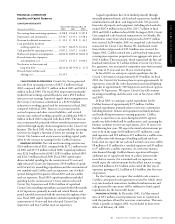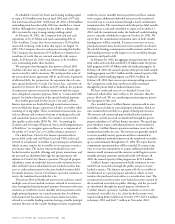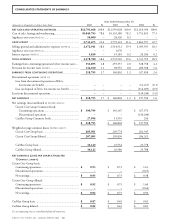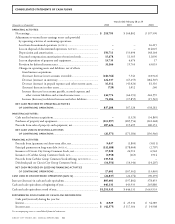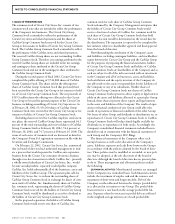CarMax 2002 Annual Report Download - page 32
Download and view the complete annual report
Please find page 32 of the 2002 CarMax annual report below. You can navigate through the pages in the report by either clicking on the pages listed below, or by using the keyword search tool below to find specific information within the annual report.
CIRCUIT CITY STORES, INC. ANNUAL REPORT 2002 30
We believe comparable store used-car unit sales growth,
which drives our profitability, will be in the low to mid-teens in
the first half of fiscal 2003, moderating to high-single to low-
double digits in the second half. Fiscal 2003 will be a year of
transition for CarMax as it ramps up its growth pace. Additional
growth-related costs such as training, recruiting and employee
relocation for our new stores will moderate earnings growth. In
addition, we anticipate a reduction in yield spreads from the
CarMax finance operation as interest rates rise above the low lev-
els experienced in fiscal 2002. Our earnings expectations for
CarMax also include preliminary estimates of expenses expected
to be incurred in the second half of fiscal 2003 if the planned
separation is approved. We expect the expense leverage improve-
ment achieved from total and comparable store sales growth to
be substantially offset by these three factors. As a result, we
anticipate earnings per CarMax Group share of 95 cents to
$1.00 for fiscal 2003, excluding the non-recurring costs of sepa-
ration, which are not tax-deductible and are estimated to be
approximately $8 million, or 8 cents per CarMax Group share.
We plan to open six to eight CarMax stores per year in fiscal
2004 through fiscal 2006, including openings in mid-sized
markets and satellite stores in existing markets.
RECENT ACCOUNTING PRONOUNCEMENTS
In July 2000, the Financial Accounting Standards Board issued
EITF No. 00-14, “Accounting for Certain Sales Incentives,”
which is effective for fiscal quarters beginning after December 15,
2001. EITF No. 00-14 provides that sales incentives, such as
mail-in rebates, offered to customers should be classified as a
reduction of revenue. The Company offers certain mail-in
rebates that are currently recorded in cost of sales, buying and
warehousing. However, in the first quarter of fiscal 2003, the
Company expects to reclassify these rebate expenses from cost
of sales, buying and warehousing to net sales and operating rev-
enues to be in compliance with EITF No. 00-14. On a pro
forma basis, this reclassification would have increased the fiscal
2002 Circuit City Stores, Inc. gross profit margin by 12 basis
points and the expense ratio by 10 basis points. For fiscal 2001,
this reclassification would have increased the gross profit margin
and the expense ratio by 20 basis points. For the Circuit City
Group, this reclassification would have increased the gross profit
margin by 18 basis points and the expense ratio by 17 basis
points in fiscal 2002, and the gross profit margin by 29 basis
points and the expense ratio by 27 basis points in fiscal 2001.
The Company does not expect the adoption of EITF No. 00-14
to have a material impact on its financial position, results of
operations or cash flows.
In June 2001, the FASB issued Statement of Financial
Accounting Standards No. 141, “Business Combinations,” effec-
tive for business combinations initiated after June 30, 2001, and
SFAS No. 142, “Goodwill and Other Intangible Assets,” effective
for fiscal years beginning after December 15, 2001. Under SFAS
No. 141, the pooling of interests method of accounting for busi-
ness combinations is eliminated, requiring that all business com-
binations initiated after the effective date be accounted for using
the purchase method. Also under SFAS No. 141, identified
intangible assets acquired in a purchase business combination
must be separately valued and recognized on the balance sheet if
they meet certain requirements. Under the provisions of SFAS
No. 142, goodwill and intangible assets deemed to have indefi-
nite lives will no longer be amortized but will be subject to
annual impairment tests in accordance with the pronouncement.
Other intangible assets that are identified to have finite useful
lives will continue to be amortized in a manner that reflects the
estimated decline in the economic value of the intangible asset
and will be subject to review when events or circumstances arise
which indicate impairment. For the CarMax Group, goodwill
totaled $20.1 million and covenants not to compete totaled $1.5
million as of February 28, 2002. In fiscal 2002, goodwill amorti-
zation totaled $1.8 million, and amortization of covenants not to
compete totaled $931,000. Covenants not to compete will con-
tinue to be amortized on a straight-line basis over the life of the
covenant, not to exceed five years. Application of the nonamorti-
zation provisions of SFAS No. 142 in fiscal 2003 is not expected
to have a material impact on the financial position, results of
operations or cash flows of the Company. During fiscal 2003, the
Company will perform the first of the required impairment tests
of goodwill, as outlined in the new pronouncement. Based on
preliminary estimates, as well as ongoing periodic assessments of
goodwill, the Company does not expect to recognize any material
impairment losses from these tests.
In August 2001, the FASB issued SFAS No. 143, “Account-
ing For Asset Retirement Obligations.” This statement
addresses financial accounting and reporting for obligations
associated with the retirement of tangible long-lived assets and
the associated asset retirement costs. It applies to legal obliga-
tions associated with the retirement of long-lived assets that
result from the acquisition, construction, development and the
normal operation of a long-lived asset, except for certain obliga-
tions of lessees. This standard requires entities to record the fair
value of a liability for an asset retirement obligation in the
period incurred. SFAS No. 143 is effective for fiscal years begin-
ning after June 15, 2002. The Company has not yet determined
the impact, if any, of adopting this standard.
In August 2001, the FASB issued SFAS No. 144, “Account-
ing for the Impairment or Disposal of Long-Lived Assets,”
which supersedes both SFAS No. 121, “Accounting for the
Impairment of Long-Lived Assets and for Long-Lived Assets to
Be Disposed Of,” and the accounting and reporting provisions
of Accounting Principles Board Opinion No. 30, “Reporting the
Results of Operations-Reporting the Effects of Disposal of a
Segment of a Business, and Extraordinary, Unusual and Infre-
quently Occurring Events and Transactions,” related to the dis-
posal of a segment of a business (as previously defined in that
Opinion). SFAS No. 144 retains the fundamental provisions in
SFAS No. 121 for recognizing and measuring impairment losses
on long-lived assets held for use and long-lived assets to be dis-
posed of by sale, while also resolving significant implementation
issues associated with SFAS No. 121. The Company is required
to adopt SFAS No. 144 no later than the fiscal year beginning
after December 15, 2001, and plans to adopt the provisions in
the first quarter of fiscal 2003. The Company does not expect
the adoption of SFAS No. 144 to have a material impact on its
financial position, results of operations or cash flows.



